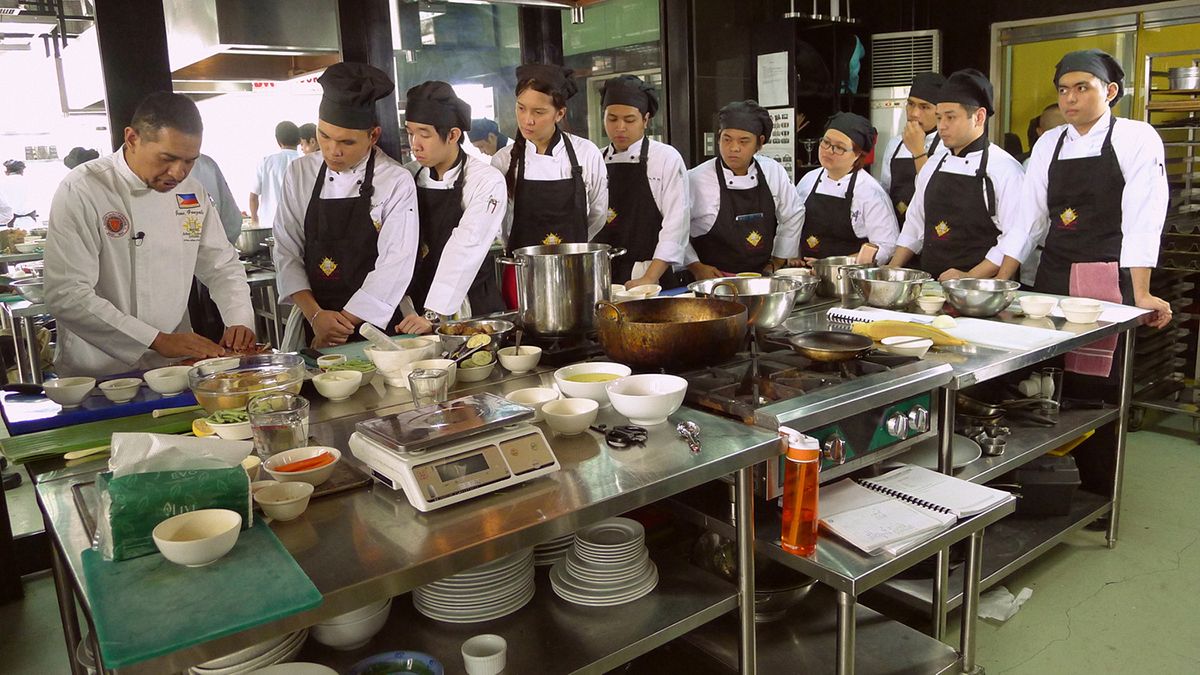The Philippines not only offers white beaches and a turquoise sea – the home-grown cuisine seduces visitors as well. Adobo, Lechon and Pancit are typical dishes and reflect the cultural diversity of the country. In this edition of Philippine Life we’ll take you on a culinary journey through the world of Filipino cuisine.
All eyes are on one of the most famous chefs of the country, Gene Gonzalez. He teaches his students first hand the secrets of the country’s finest cuisine.
“Filipino cuisine speaks of the flavours of the islands. We have 7000 plus islands, it’s an archipelago and we have distinct dishes in every island. Our cuisine is basically a very natural cuisine. We want to present ingredients in their most pristine state,” he explains.
Students come from far and wide for a chance to become ambassadors for the country’s famous dishes.
Over 1500 have graduated since Gonzalez set up the Centre for Asian Culinary Studies in Manila 13 years ago.
Becoming a chef is one of the most popular professions in the Philippines right now.
“I grew up with a big family who really love to cook and they have their own special dishes. So as a kid they would want us to watch them cook their dishes whenever we had celebrations like birthdays. So it’s a big thing for a family,” says Jolly Espina, one of the students.
Jr Roiyol another student adds, “It teaches us a lot of things. Simple techniques that you wouldn’t really just learn by cooking at home and more importantly I guess, the explanation of why you do such combinations and flavours.”
On today’s menu: the most popular fish of the archipelago Lapu-Lapu. Gene R. Gonzalez who is the President of the Centre for Asian Culinary Studies showed how to prepare Lapu Lapu.
“This is a coral snapper, what we call Lapu Lapu. What you want to do is fill the cavity with some aromatics. Ginger, lemongrass, we put some tomatoes, some onions, we mix that all together and what we want to do is to stuff this fish with the aromatics that we have. We can wrap it now in a banana leaf which will give it a very herbal aroma. So this fish is ready for grilling.”
Philippine cuisine is a unique melting pot of cultures – with Spanish, Malay, Chinese, Japanese and American influences all contributing to the colourful cuisine that has evolved over the centuries.
The fresh produce is sold in so-called wet markets, because the floors are wet from washing the food.
Like most Filipinos, Gonzalo Misa gets to the market early in the morning. On his shopping list are the ingredients for the national dish: adobo, which can be cooked with a variety of ingredients. Mostly it’s prepared with chicken, beef, pork or fish then cooked with garlic, salt and pepper in a vinegar and soy sauce.
“We love to eat. First let me tell you, we eat about five times a day. You know for Filipinos eating is a social thing. Many of us don’t like to eat alone,” he explains.
To get to the heart of Filipino cuisine we travel to the province of Pampanga, 90 kilometres north of the capital, known as the country’s culinary centre.
It is also home to one of the most well-known chefs in the country: Claude Tayag. He is not only a master in the kitchen but also an accomplished artist and writer. In his house Bale Dutung – which means house of wood – he serves up local authentic delicacies like Sisig, an appetizer made of chopped pig’s cheeks, head and ears.
So what is it that makes the food here stand out from the rest of the country?
“In general I would say it’s the taste bud that a Pampangos (a local person) has. He is used to having rich food. If the recipe asks for a tablespoon of butter he would put two. Something like that. You always ask yourself something like, “how can I improve that dish?” Filipino cuisine is about a balancing act between the sweet, sour, salty, bitter, all of that combined.”
From heavenly feasts to another kind of paradise: in the next edition of Philippine Life we’ll be travelling to Palawan. The island on the shores of the Sulu Sea is considered one of the most beautiful here. We’ll discover the treasures of its rich biodiversity as well as a mystical underground river.
In this exclusive video Chef Gene Gonzalez demonstrates his recipe of the Philippine national dish Adobo.
(function(d, s, id) { var js, fjs = d.getElementsByTagName(s)[0]; if (d.getElementById(id)) return; js = d.createElement(s); js.id = id; js.src = "//connect.facebook.net/fr_FR/all.js#xfbml=1"; fjs.parentNode.insertBefore(js, fjs); }(document, 'script', 'facebook-jssdk'));Publication de euronews.
------------------------------------------------------------------------------
Chef Gene Gonzalez shares some of his delicious recipes with Euronews
KAPAMPANGAN ADOBO
Ingredients:
1 ½ cups pork, cut into 1” cubes
1 ½ cups chicken cut in 3” pieces
½ cup chicken heart
½ cup beef liver, cut into ¼” cubes
½ cup pork kidney, cut into 1” cubes
½ cup chicken giblets, cleaned
¼ cup chicken blood, cut into 1” cubes
1/2 cup vinegar
2 tbsp corn oil
½ tbsp cracked pepper
2 tbsp garlic
¾ tbsp salt
6 tbsp fish sauce
3 tbsp pork lard
2 cups chicken stock #### Procedure:
- Sauté garlic in corn oil until slightly brown. Add pork cubes, chicken, chicken heart, beef liver, pork kidney, beef liver, pork kidney, chicken giblets and chicken blood.
- Add Arengga vinegar, pepper then fish sauce.
- Take-out chicken giblets and heart, beef liver and chicken blood. Continue braising.
- Add all variety meats when chicken and pork are tender and sauce turns brown.
- Simmer for 15 minutes then separate from meat. Set aside.
- Fry meat in pork lard until brown and lightly crusty. Serve with sauce on the side. —————————————————————————
APALIT KARE-KARE SPECIAL
Ingredients:
6 tbsp atsuete oil
1 tbsp garlic, chopped
2 tbsp onion, sliced
¼ cup sitaw
¼ cup puso ng saging
¼ cup eggplant, long
1 ½ kilos oxtail, cleaned and preboiled
3 tbsp toasted ground rice
2 tbsp peanut butter
2 tbsp toasted ground peanut
4 – 6 cups stock from pre-boiled oxtail oil #### Procedure:
- Sauté garlic and onion in atsuete oil
- Add softened ox tail.
- Add the toasted rice, toasted peanut and peanut butter. Simmer until thick.
- Add vegetables except eggplant which will be added 10 minutes before serving.
- Simmer to cook.
- Serve with guisadong alamang. —————————————————————————
ALAMANG GUISADO
Ingredients:
½ kilo bagoong, washed well and drained
3 tbsp garlic, minced
3 tbsp onion, chopped
3 tbsp corn oil
3 tbsp sugar
Homemade chicharon #### Procedure:
- Sauté garlic in corn oil until golden brown. Add onions and washed bagoong alamang. Continue sautéing.
- Add sugar. Simmer to cook. Top with homemade chicharon.= —————————————————————————
LAING
Ingredients:
4 cups gata, diluted in 2 cups water
1 cup milk
1 kilo laing (gabi), fresh
½ cup shrimps
1 cup porkloin, sliced into small pieces
¼ cup onion, sliced
¼ cup ginger, sliced into strips
1 tbsp garlic, minced
2 tbsp salt
1 ½ tbsp fish sauce
2 pieces bird’s eye chili, sliced
2 tbsps oil
3 tbsps roasted balao (shrimp paste) #### Procedure:
- Sauté garlic, onion and ginger in oil. Add the porkloin and shrimps.
- Stir for few minutes then add the instant gata and milk. Let boil. When boiling add the laing (taro leaves).
- Season with salt and fish sauce. Add the bird’s eye chili (siling labuyo).
- Let boil for more to cook. NOTE: When using dried Laing – use 3x Coco Cream
—————————————————————————
PINAIS NA LAPU-LAPU
Ingredients:
1 Lapu-lapu (Milkfish)
3 tbsp sliced tomatoes
3 tbsp sliced onions
1 tbsp julienned ginger
1 tbsp finely sliced lemongrass bulb
1 banana leaf (softest section) #### Procedure:
1.Stuff Lapu-lapu with the mixture.
2.Wrap in banana leaf and grill over hot charcoal.
3.Good dips are buro or a simple mixture of calamansi or dayap and patis. #### The chef says:
Buro, a combination of fermented rice and salted fish, traces its roots to the mountain people of South Asia.
Buro isda is originally from Pampanga and Bulacan. This can be bought in fish sections of wet markets. To make guisadong buro, sauté 1 tsp garlic with 1 tbsp onion and 2 tbsp chopped tomatoes in a little cooking oil. Add 1 cup buro and simmer for 3 minutes. Serve.
—————————————————————————
PINAIS NA TIYAN NG TUNA
Ingredients:
½ kg tuna belly
1 banana leaf
2 tbsp finely chopped lemongrass bulb (soft part only)
½ cup deep-fried onions
salt and pepper #### Procedure:
- Lay tuna belly on a banana leaf.
- Add deep-fried onions, lemongrass bulb, salt and pepper to taste.
- Wrap in the banana leaf, then grill. #### The chef says:
This is delicious with guisadong bihod or a dip of dayap, patis and chili.



